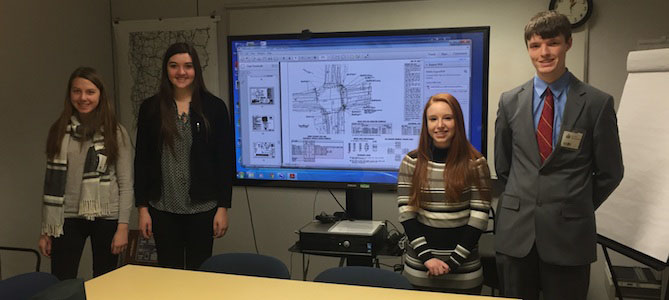Students often seek us out for information about sustainability issues, and helping these young activists is one of the most satisfying things about our work. A recent example is Jack Carnahan, a senior from Champlain Valley Union High School in Hinesburg, Vermont, who contacted us asking for help on an issue that we care deeply about: vehicle idling.
Jack was creating an initiative he called “Bright Lights: Go Green” to address a troublesome intersection in his community that lacks a protected left turn signal. He said congestion at the intersection results in a tremendous amount of vehicle idling that could be avoided by modifying the light cycle. Jack and the Bright Lights team discovered our I Turn It Off anti-idling campaign during their research. We were more than happy to provide research assistance and send over materials to help raise awareness. Here’s more about Jack and his project:
Sustainable America: What inspired you to create the Bright Lights: Go Green initiative?
Jack Carnahan: As part of a class I was taking — Money, Energy, Power — our final assignment was to create an activist group around an energy problem. I was inspired to make our activist group deal with this ineffective traffic light cycle because I have to drive through it every day on the way to school and I spend a great deal of time idling while waiting to turn left. This qualified as an energy problem because we estimated some 21 tons of CO2 are emitted per year due to idling in one lane because of this light.
SA: How did your group investigate and document the problem?
JC: My group set up a camera at the intersection to record traffic from 7:00 to 8:15 a.m., which is when traffic is heaviest. We then used tools, such as Argonne National Laboratory’s Idle Reduction Savings Calculator, to calculate fuel loss and CO2 emitted at the light.
SA: What did you do with the research?
JC: We took all of our research and data to the Vermont Agency of Transportation to pitch our case. Unfortunately, we were not approved because, due to federal funding, the agency has to use a specific data collection tool. They would also have to unlock federal funds, which takes a considerable amount of time. By the time they could access the funds to change the light, the project they have planned to expand the intersection to include turn lanes would have started, so it wouldn’t have been worthwhile.
Our group was completely unaware that the agency would have to go through so many steps to execute our plan. This coupled with the fact that our data was not gathered with the tool that they gather data with really brick-walled our proposal.
SA: Will the traffic pattern ultimately be fixed with the expansion of the intersection?
JC: Yes – to an extent. The Route 116 Final Corridor Plan adds turn lanes, introduces pedestrian-friendly infrastructure, and reallocates the responsibility for traffic signal maintenance and street lights to the City of Hinesburg. Together, these elements are expected to improve the traffic pattern.
SA: What has been the reaction from your classmates, teachers and the community about your project?
JC: Everyone we have talked to, teachers, students and the community, has been overwhelmingly positive. Many of the people who attend or work at the school have had some experience with the problem we were addressing and were pretty glad we wanted to fix it.
SA: What have you learned about vehicle idling since starting the initiative?
JC: This initiative has taught me that vehicle idling is pretty bad on a large scale. I used to think that it was all right to idle my car for a while to get it warmed up and that the environmental impacts were small, but since I saw how much CO2 could be emitted in less than an hour at just one intersection, I learned that cars idling really is a big deal.
Although the Bright Lights group encountered a vital challenge to accomplishing their goal, their efforts still raised awareness within the Hinesburg community about the issue of vehicle idling. Their experience also demonstrates some of the challenges associated with trying to enhance our infrastructure to mitigate idling. We are excited to support engaged students like Jack Carnahan and the Bright Lights: Go Green group. Even though the project didn’t reach its goal, the experience and knowledge these students gained is invaluable, and we hope they inspire others to tackle sustainability issues in their communities.
Katy Franklin
Administrative Assistant
RELATED ARTICLES
7 Ways to Take Action on Idling
College Student Speaks Out About Idling
Students Seeking Fuel Cell

